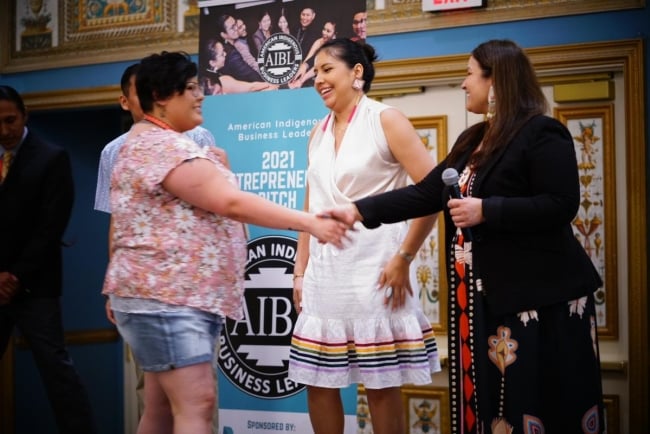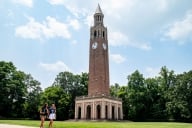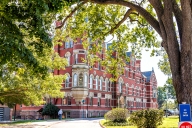You have /5 articles left.
Sign up for a free account or log in.

Angelique Albert, CEO of the Native Forward Scholars Fund, greets participants at an American Indigenous Business Leaders conference.
Native Forward
Izzy Yasana, a member of the Klamath Modoc tribe in Oregon, has always wanted to earn a graduate degree, but she didn’t have the time and couldn’t afford it. Her husband is an elementary school physical education teacher; she was working full time at Nike Inc. They wanted to save money to support their growing family.
“We’re just trying to survive over here,” she said. She remembers asking herself, “How do I gather that funding? I don’t have the means to be able to have a family and follow my academic dreams.”
Yasana, now a mother of two, found a way. The Native Forward Scholars Fund, a national scholarship fund for Native American students, formerly named the American Indian Graduate Center, financed her graduate education, including housing costs, at Gonzaga University in Washington State. She earned an M.B.A. in American Indian entrepreneurship in May while continuing to work as a value brand manager at Nike and serving as chief of staff of the company’s Native American employee network.
She’s now considering pursuing a Ph.D.
“It completely opened my eyes to other opportunities within Indian country that we can tackle,” she said of the entrepreneurship program. “I don’t want to put a timeline on it, but in the near future, I am thinking about what could a Ph.D. look like for myself and then how can I now affect students in that space.”
Yasana gets emotional when she talks about the scholarship. The funding freed her from extra stress and debt, but more than that, it also validated her dreams and assured her that people in her community believed “this person can succeed, so I’m going to give them the resources that they need.”
Native Forward has doled out awards to more than 20,000 undergraduate and graduate students since its founding over 50 years ago. The fund was originally created to support Native Americans pursuing graduate education, and about 60 percent of its scholarships go to graduate students. The organization is currently in the process of expanding its support services and reach in hopes of lifting graduate degree attainment among Native Americans.
A 2018 report by the Education Trust, a research and advocacy organization focused on closing equity gaps in education, found that only 24 percent of Native American, Alaskan Native and Native Hawaiian adults had earned a college degree at the associate’s degree level or higher, compared to 47 percent of white adults. Only 4.8 percent of Indigenous adults held a graduate degree compared to 13.4 percent of white adults.
“It’s a whole systemic issue,” said Carrie Billy, president and CEO of the American Indian Higher Education Consortium. She noted that low high school and college graduation rates among Native Americans lead to fewer Native Americans in graduate school, which in turn means “there aren’t a lot of American Indians with Ph.D.s … There aren’t a lot of role models for younger American Indians to emulate.”
Meanwhile, tribal colleges provide undergraduate research programs and encourage students to continue their education, but these institutions generally lack the funding to sustain their own permanent graduate programs, she said. As a result, students have to go to graduate school elsewhere, where they may be “the only … American Indian or Alaska Native in that program.”
Native Forward is launching a new mentorship program that draws on its alumni network to help scholarship recipients navigate graduate school. The fund began offering awards dedicated to supporting doctoral research and midyear scholarships to sustain students financially throughout the academic year. Awards are also now available to students who are descendants of tribe members or part of state-recognized tribes, in addition to federally recognized tribe members.
“From an organizational standpoint, financial resources continues to be the No. 1 barrier for our students, hands down,” said Angelique Albert, CEO of Native Forward. She noted that applicants, who often come from low-income families, have $26,000 of unmet financial need per year on average, while the average Native Forward scholarship is about $10,000 per year. Of the roughly 15,000 Native American graduate students in the country, about 4 percent receive awards from Native Forward.
“There’s still a huge funding gap,” she said.
Albert said students need more than financial help to persist and thrive in college.
“You need mentorship,” she added. “You need culturally congruent pathways,” which is why each award recipient has a “one-to-one relationship” with a Native Forward staff member who can offer guidance alongside formal mentors.
Professor emerita Henrietta Mann, formerly the endowed chair in Native American studies at Montana State University, Bozeman, is a former recipient and mentor. After she earned her master’s degree in English at Oklahoma State University in the 1970s, the University of California, Berkeley, hired her to teach Native American studies. She was eager to teach Native American students, but “much to my dismay, I had no Indian students in my class.”
Mann, who also previously directed the federal Office of Indian Education Programs and served as deputy to the assistant secretary for the federal Bureau of Indian Affairs, had hoped to be the kind of role model for Native American students she wished she’d had in college.
“I was heartbroken, because I felt like those were the ones that I really wanted to help, to help them understand their histories, their cultures and where they come from.”
Mann thought she could set an example for Native American students and decided to pursue a doctorate in American studies at the University of New Mexico.
“I wanted them to achieve all their dreams to become those scientists, those educators, those administrators … that we need so badly, because too often we matriculate and are educated in a world where you seldom see another brown face,” she said.
She moved her family, including her then terminally ill husband, their four children and her aunt, to Albuquerque, determined to get that degree. She took out loans and received a “modest” scholarship from Native Forward. She can’t remember the amount but said it felt like a “fortune” at the time. This was after she had already struggled to pay for her undergraduate degree, sustaining herself on care packages of food from her family.
“I don’t want my grandchildren … going through what I went through,” she said.
Educational disparities among Native Americans are getting renewed attention as higher education leaders and state and federal policy makers confront the country’s past. U.S. Secretary of the Interior Deb Haaland, the first Native American in the position, announced an initiative last year to examine the troubling history of federal boarding schools for Native American students, following a similar national effort in Canada. These schools were known to subject students to malnourishment, poor health care and rampant physical, sexual and verbal abuse.
Albert, the CEO of Native Forward, said the “damaging” legacy of federal boarding schools still haunts tribal communities and motivates Native students to become teachers and professors to “educate our own people.”
Mann said the boarding schools not only had a policy to squelch Native American language and culture but also gave students a second-rate education that left them ill prepared to pursue advanced degrees and professional careers. These schools provided “a very rudimentary, a very elementary kind of education—reading, writing and arithmetic—and then half the day was generally devoted to learning a trade of some kind: harness making, blacksmithing, baking, cooking, housekeeping, sewing,” she said.
“We were never intended to be educated to become doctors, scientists, engineers, on and on,” she said. “We were to become second-class citizens, to learn to speak the English language with no cultural relevancy. The beauty of it is we have survived.”
Mann said watching students like Yasana rewrite that narrative by getting advanced degrees, and getting the financial support they need, makes her hopeful about the future of Native Americans in graduate education.
“When I look at young people like Izzy, my heart just sings,” she said.


.png)




_edit.jpg?itok=d3X97aqv)

